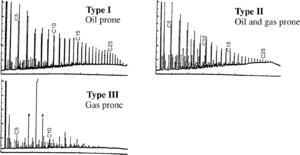Difference between revisions of "Pyrolysis gas chromatography"
(Initial import) |
m (Matt moved page Using pyrolysis gas chromatography to assess quality to Pyrolysis gas chromatography: more generic) |
(No difference)
| |
Revision as of 13:45, 24 January 2014
| Exploring for Oil and Gas Traps | |

| |
| Series | Treatise in Petroleum Geology |
|---|---|
| Part | Critical elements of the petroleum system |
| Chapter | Evaluating source rocks |
| Author | Carol A. Law |
| Link | Web page |
| Store | AAPG Store |
What is Py-GC?
Pyrolysis gas chromatography (Py-GC) is anhydrous thermal decomposition of a material that leads to the conversion of kerogen to hydrocarbon compounds. Py-GC can be conducted on whole rock or isolated kerogen samples to obtain a visual signature or “fingerprint” of the organic material present.
How to read gas chromatograms
Gas chromatography generally is a qualitative tool. It is not typically used as a quantitative measurement of hydrocarbon molecules. However, the patterns generated in the chromatograms can help us determine if a source rock will be oil or gas prone.
The X-axis of a gas chromatogram is retention time, and the Y-axis is the relative quantity of each compound. Each spike in the chromatogram represents a particular hydrocarbon compound, beginning with lowest number of carbon atoms in the compound on the left and going to higher chains of carbons to the right. The height of the spike represents the relative abundance of the compound pyrolized from the sample's kerogen. Typical gas chromatogram examples for types I, II, and III kerogen are shown below.
Interpreting gas chromatograms
A gas chromatogram is evaluated qualitatively to determine the potential of a rock to generate oil vs. gas. The table below shows how chromatograms for oil- vs. gas-prone rocks are evaluated.
| Chromatograms of oil-prone rock | Chromatograms of gas-prone rock |
|---|---|
| Dominated by long-chain carbon compounds (greater than C10 ) | Dominated by short-chain carbon compounds from C1 –C4 |
| Contain carbon compounds up to C25 or greater | Contain very few carbon compounds above C10 |
See also
- Evaluating source rock quality
- Kerogen types
- Evaluating quality using rock-eval HI/OI
- Visually assessing quality
